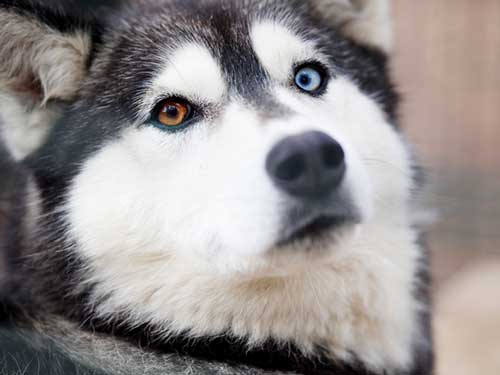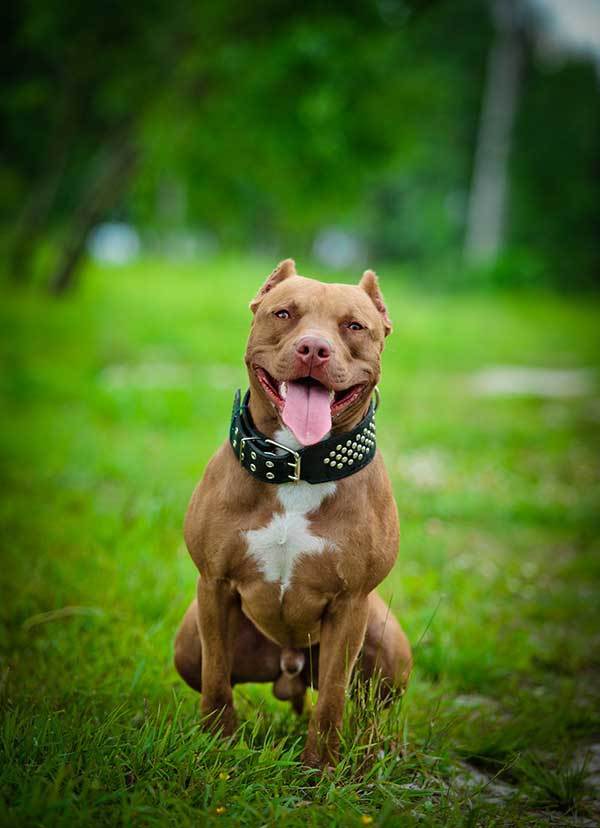It’s common knowledge that dogs have a sense of smell far more advanced than humans. They also seem to hear sounds at greater frequencies than us. But just how powerful is their sense of sight?
The best way to answer that question is to rephrase it in terms of the average distance dogs can see. So, how far can a dog see?
Dogs aren’t as gifted in the sight docket as they are in the smell and hearing ones. Most dogs with perfect eyesight can see clearly from a paltry 20 feet (6 meters) away. Anything beyond this will appear blurry to your canine friends.
If you’ve always wondered why your dog doesn’t seem to recognize you from several feet away, you’ve come to the right place.
Read on as we delve deeper into what a dog’s sense of sight entails and how it measures up to a human’s.
Table of Contents
Can Dogs See Long Distance?
You may have come across several publications terming dogs as myopic (near-sighted). Note that this assertion is only true when a dog’s sense of sight is viewed in relation to ours.
In other words, near-sightedness in dogs isn’t a distinct medical condition. Rather, it’s how these animals are inherently born.
More About Canine Eye Anatomy
Before we examine the efficiency of a dog’s sense of sight, it would be best to begin by understanding what constitutes their eye anatomy.
Now, the anatomy of a dog’s eye shares certain fundamental similarities with that of a human eye. However, there are also some recognizable differences.
Components of a Dog’s Eye Similar to a Human’s
- Sclera – The whitish fibrous membrane of the eye that, together with the cornea, constitutes the outer covering of the eyeball
- Cornea – The thin, clear, and highly-delicate layer located at the front of the eye
- Conjunctiva – The lining of the eyelids that usually become pinkish and/or inflamed when a dog has an eye infection or allergies, or is excited
- Iris – The colored section of the eye made up of flexible muscles that control the changes in pupil size as a way of regulating the amount of light penetrating the eye
- Pupil – The black area at the center of the iris that dilates in dim light or contracts in bright light
- Lens – The part behind the iris that changes shape to transmit light to the retina
- Retina – The part at the back of the eye made up of photoreceptors that sense light and movement (known as rods) and those that sense color (known as cones)

Components of a Dog’s Eyes That Humans Don’t Have
1. Nictitating membrane
Also known as the third eyelid, this is the whitish color located at the corner of a dog’s eyes right next to the nose.
The nictitating membrane primarily protects a dog’s eyes from scratches. It also moves seamlessly across the eye when a dog blinks, helping in tear production.
2. Tapetum lucidum
The tapetum lucidum is a component of a dog’s eye located behind the retina, which reflects light through the retina to focus more light on the photoreceptors.
This is the part that makes the eyes of many animals glow at night. It’s also the reason many animals have a better sense of sight at night than humans.
What Colors Can a Dog’s Eye Have?
The iris is the component most responsible for the coloration of a dog’s eyes. The iris of most healthy and normal dogs can range from brown and blue to golden or hazel.
Brown tends to be the dominant iris color. However, the color may vary depending on genetic factors and the overall color of a dog’s face.
It’s also worth noting that the iris of some dogs can have a blend of two or even more different colors. This is usually common in canines with a merle coat pattern as well as certain breeds like Australian Shepherds and Huskies.
There’s a common misconception that blue-eyed dogs have poorer eyesight and are more susceptible to vision problems than their brown-eyed counterparts. But as we’ve just indicated, blue is a normal doggy eye color, besides of course adding an extra layer of charm to a dog’s face.

How Far Can Dogs See Clearly?
We’ve already indicated that most healthy dogs will see no further than 20 feet away. We’ve also gone through the components of a dog’s eyes and the role each plays in aiding vision.
Perhaps the next focus point should be the specific aspects of vision that determine a dog’s overall eyesight efficiency.
What Is a Dog’s Visual Acuity Like?
Visual acuity is a measure of how clear an animal can pick up details visible to their eyes. In humans, visual acuity is determined by the ability to make out the letters on an eye chart.
If you look at an eye chart from 20 feet away and are able to read the letters as accurately as a person with normal eyesight can from the same distance, then you’re deemed to have a 20/20 vision. But if the last letters you can pick up are the same that a person with normal vision can read from 40 feet away, then you’re said to have a 20/40 vision. And the bigger the disparity gets, the smaller the fraction becomes.
Unlike humans, dogs are unable to read. Or at least they can’t report back to us what they’ve read.
The best way to test a dog’s visual acuity is by using a pattern comprising black and white vertical stripes. But on average, numerous studies have placed a dog’s visual acuity at a paltry 20/75.
What Is a Dog’s Motion Perception Like?
Dogs may have difficulty making out objects from a distance. But what they lack in visual acuity they make up for in incredible motion detection abilities.
Canines are extremely gifted at sensing movement. A dog can detect moving objects from up to 800 meters away. So, your dog may not be able to clearly see something or someone from a distance. But he’ll certainly respond in a certain way if the thing or person moves.
The following are some tell-tale signs that your dog is detecting some motion even if not necessarily seeing the person or object clearly;
- Tilting their head as if analyzing the person/object
- Sniffing the air for hints of familiar scents from the moving person/object
- Sharp movement of the ears from a pulled-back to an erect position
- Freezing in place
The reason dogs surpass humans in motion perception is that they have more rod cells than ours. For comparison, humans have about 91 million rods in their retinas while studies indicate that dogs can pick up motion 10 to 20 times better than us. So, you can only imagine how many rod cells your canine friend has.

What Is A Dog’s Range Of Vision Like?
Range of vision basically denotes the extent to which an animal can see from the farthest ends of its eyes, usually measured in degrees. It’s also known as field of vision, field of view, or peripheral vision.
Peripheral vision depends primarily on eye location. The further the eyes are from each other, the larger the field of view.
Now, a dog’s eyes are located on the side as opposed to the front of his head. That gives them a better field of vision than humans.
For comparison, dogs have a peripheral vision of around 250 degrees while a human’s field of view is about 190 degrees. That means our canine friends can see a whopping 60 degrees better than you. No wonder they’re more efficient at picking up objects approaching from behind.
Can Dogs See In Color?
There’s a common misconception that dogs see the world in black and white. Well, this isn’t exactly true.
Dogs can see color. However, most canines are more efficient at perceiving shades of blue and yellow, with many also able to detect shades of green.
The reason dogs have limited color perception is that they only have two color receptor cones compared to humans who have three.
Since dogs are only capable of detecting two colors, they’re said to have dichromatic vision. Humans have trichromatic vision, which denotes an ability to see more colors.
Can Dogs See Shapes?
Since dogs have diminished color perception, it’s natural to wonder whether they can clearly make out shapes. It turns out that they can.
Numerous studies have shown that dogs can see both in 2 and 3 dimensions.
That pretty much explains why a dog may react to the sight of a human differently than it does to other dogs. It also explains why some canines may reject their food bowl or litter box just because it looks ‘odd.’

How Far Can a Dog See At Night?
‘How far can dogs see in the dark?’ This is a question that continues to boggle the minds of many pet parents worldwide.
Opinion seems divided right down the middle on the matter. Some pet owners believe that dogs have better night vision than humans while others have the contrary opinion.
So, how far can dogs see at night?
Remember what we mentioned about dogs having more rods in their eyes than humans? That mere fact suggests our canine friends can see better at night than us.
Besides, dogs have much bigger pupils than humans. Their larger pupil works synergistically with their tapetum lucidum to let more light into their eyes.
But perhaps the more pertinent question should be, ‘how far can a dog see in the dark?’
That’s because not all nights are pitch black. Moonlit nights are definitely clearer. The same is true for well-lit neighborhoods.
Now, humans will struggle to see an object that’s 10 feet away in the dark. However, most dogs, can clearly pick up the same objects in pitch black.
Do dogs need a light at night?
Although dogs can see better than humans in the dark, their nighttime vision is still far diminished than their daytime one. So, your pooch may still require light at night to make up objects located considerably further away.
Can Dogs See Farther Than Humans?
A dog can see farther than humans both in well- and dim-lit conditions. But just how far can dogs see compared to humans?
Humans can clearly pick up patterns located up to 75 feet away while dogs will clearly see the same objects only 20 feet away. That’s why humans are said to have a 20/20 vision while dogs have a 20/75 vision.
How Far Away Can A Dog Sense Its Owner?
Based on visual acuity alone, a dog can sense his owner from 20 feet away. However, note that factors like motion and color may affect this average distance.
Besides, a dog may detect his owner from several feet away using his sense of smell, which is far superior to his eyesight.
Does Breed Determine a Dog’s Vision?
Doggy eyesight can range considerably from one breed to another. Which begs the question, what dog has the best eyesight?
Labradors have the best eyesight of all dog breeds. Some research indicates that Labradors have closer to 20/20 vision, nearly the same as humans. That explains their extensive use as guide dogs.
Other dog breeds famous for their superior eyesight include Basenjis, Greyhounds, and Rhodesian Ridgebacks.
Which Dogs Have The Worst Eyesight?
English springer spaniels, Siberian huskies, and Boston terriers are all noted for their terrible vision. The same is true for poodles, German shepherds, collies, pitbulls, and Great Danes.
How Far Can A Pitbull See?
Considered one of the dog breeds with the poorest eyesight, most pitbulls will only see clearly objects that are 12 to 15 feet away.

Does Age Determine a Dog’s Vision?
Age also plays a role in a dog’s overall eyesight. Puppies generally have poorer vision than adult dogs.
How far can puppies see?
Puppies, like most mammals, are born blind. Their eyes first open after a few days, usually 10 to 14. However, most dogs will have their eyes fully developed by the eighth week.
So, how far can an 8-week-old puppy see?
If you’ve always wondered, ‘how far can dogs see at 8 weeks,’ the answer is true for mature dogs – 20 feet away.
Conclusion
Dogs surpass us in both the senses of smell and hearing. But they don’t score so highly in terms of eyesight. Most dogs have a 20/75 vision. That means their visual acuity is up to thrice less efficient than ours.
Checkout Our Favorite Dog Products
1. BEST PUPPY TOY
We Like: Snuggle Behavior Toy with Heart Beat & Heat Pack – Ideal toy for new puppies.
2. BEST DOG TRAINING PROGRAM
We Like: Doggy Dan The Online Dog Trainer – Stop any dog problem and raise the perfect puppy with The Online Dog Trainer.
3. BEST DOG PUZZLE TOY
We Like: Outward Hound Interactive Puzzle Toy – Every dog loves chasing squirrels at the park. The Outward Hound Hide-a-Squirrel Puzzle Toy gives your dog the same feeling as though he was outdoors chasing live squirrels.
4. Best Bone Broth for Dogs
We Like: (Solid Gold – Human Grade Bone Broth for Dogs) – Simmered Beef Bone Broth With Turmeric Provides A Nutrient-Dense And Flavorful Addition To Your Dog’s Meal + Rich In Natural Collagen From Beef Bones.
5. Best Multivitamin for Dogs
We Like: PetHonesty 10-For-1 Multivitamin – 10 Benefits in 1 Daily Treat – These Multivitamin Snacks combine a well-rounded blend of the most essential vitamins and supplements including glucosamine, probiotics, vitamins and omegas, for dogs’ overall daily health.

